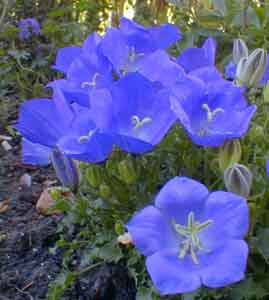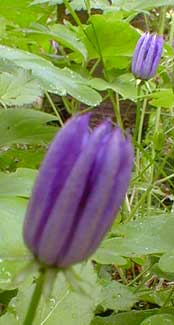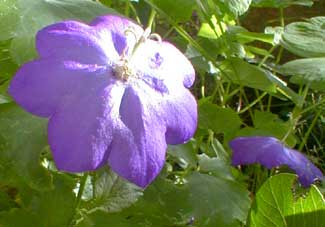
Blue Carpathian Harebell; aka,
Tussock Bellflower
"Did the harebell lose her girdle
to the lover bee?
Would the bee the harebell hallow
much as formerly?"
-Emily Dickinson
Impactful large intensely blue cups face upward from the ground, out of this eight-inch high clumping groundcover, Campanula carpatica var turbinata 'Pearl Deep Blue.' Occasionally (as shown in the third photo below) the cup-flowers open so far that they turn inside out & form umbrellas. Their blue buds, shown in the middle photo, are interesting in their own right.
 Its flowers last a very long while, in continuous bloom from June to August or first frost, though at their primary intensity for July. Trimming out spent blooms maximizes its beauty & assists continuous rebloom.
Its flowers last a very long while, in continuous bloom from June to August or first frost, though at their primary intensity for July. Trimming out spent blooms maximizes its beauty & assists continuous rebloom.It wants regular watering in well-draining organically rich soil, but overwatering can kill it. As an alpine plant it is very cold hardy, but does not do well above zone 8, preferring temperate or chilly environments, & wants protection from summer heat even in zone 8. It's great below zone 8, having no problems in zones 5 & 6, & perhaps stretchable for even colder climes.
 The variety was introduced by the Benary Seed Company of Sycamore, Illinois. In 2000, it received the FloraStar Award, given by the flower industry to new cultivars that score highly in greenhouse trials. One of the criteria for the award is that a cultivar honestly proves itself superior to earlier similar cultivars, & 'Pearl Deep Blue' earned its way by having larger flowers that begin a couple weeks earlier than similar cultivars, are less stressed in summer, & keep a more compact foliage. As an industry award, FloraStar influences what flowers go into mass production.
The variety was introduced by the Benary Seed Company of Sycamore, Illinois. In 2000, it received the FloraStar Award, given by the flower industry to new cultivars that score highly in greenhouse trials. One of the criteria for the award is that a cultivar honestly proves itself superior to earlier similar cultivars, & 'Pearl Deep Blue' earned its way by having larger flowers that begin a couple weeks earlier than similar cultivars, are less stressed in summer, & keep a more compact foliage. As an industry award, FloraStar influences what flowers go into mass production.The species is native to the Carpathian Mountains. The leaves of the variant turbinata are small, tough, pointed, with sawtooth edges, having the shape of feathers, hence the secondary common name Tussock, which means feathery or tufted.
Propogation can be by seeds surface-sown in the garden late spring to early summer. They will flower their second year in the garden. More of the powdery-fine seeds will succeed if started in a cold-frame. They can also be started from spring basal cuttings. Propogation by clump devision can be done spring or autumn.
The leaves are edible, & snails alas agree they are tasty. They are a bit tough when raw, so best cooked in soups. The flowers are visually pleasing additions to salads or stews.
Campanula cochleariifolia 'Bavarian Blue'